 |
|
Genetics
Genetics are important, because they determine everything about the newborn pig, such as how well it gets along with others, how fast it grows up, and what its meat is like. Both mother and father pass down important traits.
Most natural pork companies are very flexible about their genetic programs, often even allowing their farmers to do their own on-farm genetic selection. This usually causes their product quality and consistency to suffer. Some popular breeds, especially heirloom breeds, simply have more natural variance in their size and quality.
Because Truebridge farms get their maternal and paternal lines from the same sources, the piglets that are born will all have the same attributes, regardless of which farm they came from. This is significant for customers, who can depend on seeing the same carefully chosen meat characteristics every time. |
|
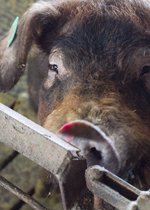 |
|
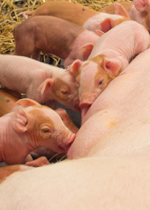 |
| A classic red-haired, floppy-eared Duroc boar. |
|
The piglets often have red patches or spots from dad. |
| |
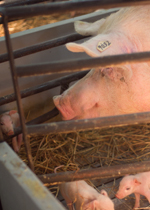 |
|
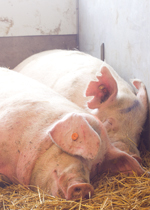 |
| The sows are selected for their mothering instincts. |
|
They are gentle natured and cohabitate well in large pens. |
| |
|
|
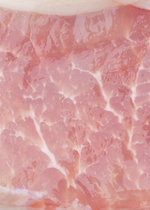 |
|
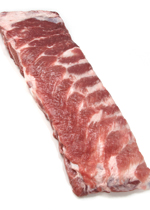 |
| Good marbling provides flavor and tenderness with little fat. |
|
Duroc genetics provide a distinctively bright red color. |
|
However, it is equally important during fabrication. When there is a wide variation in carcass size and fat cover, it becomes difficult, and in some cases impossible, to create the desired cuts. For example, carcasses from some breeds might produce very large and very small pork chops that aren't well suited for normal portion sizes. When the genetics consistent it is much easier to achieve an uniform product.
Commercial pork companies, on the other hand, tend to produce pork that is highly consistent. Most of their genetic lines were selected for leanness, with little or no consideration for other meat quality traits. The result is a product that is highly uniform and dependable, but not very tasty or easy to cook. This has led to negative perceptions of pork by many Americans, who have never experienced a flavorful cut in their lifetime of eating meat.
Meat quality was the most important consideration when choosing Truebridge genetics. Traditionally, producers have relied solely on paternal genetics to influence meat quality, but Truebridge uses both male and female lines that have been selected for multiple generations for meat quality attributes.
The sows are a cross of two white breeds imported from Europe whose genes provide good pH, marbling and color. The boars are Duroc, a heritage breed originating in Spain, developed in the United States, and now used around the world. It is often referred to as the "Angus of pigs" because it has high intramuscular fat (which provides flavor and tenderness) but low body fat. This makes it relatively lean, while still tasty and forgiving to cook. Some of the popular breeds for meat quality, such as Hampshire, Berkshire, Chester White and Tamworth, have much more inconsistent meat quality and usually far too much body fat. They also grow inefficiently, leading to a much older market pig, which can affect meat quality and be very expensive to produce.
Careful genetic selection also allows Truebridge to avoid detrimental genetic anomalies. Pigs have two well known genetic anomalies that affect meat quality. Because both are associated with lean carcasses, they have not been eliminated from many breeding programs. The porcine stress gene causes a disease called malignant hypothermia, which is triggered when the pigs are stressed and leads to PSE (pale soft and exudative) meat. The RN- gene is the other genetic anomaly, and causes high muscle glycogen stores and a longer pH decline at slaughter, leading to pale acidic meat. The effects of these two anomalies are additive, creating compound meat quality deficiencies.
Another important genetic consideration has to do with the temperament of the pigs. Simply put, some genetic lines work well with group housing and others don't. European genetic lines have been housed in groups for so long that they've been indirectly selected for docility. Truebridge sows are so gentle and good natured that an unfamiliar human could enter one of their pens and give any one a hug or a pat on the head, and be greeted with only relaxed curiosity. The sows tend to be relatively laid back even when in heat or with their piglets. This is important so that they get along well with their roommates, but also because the pens are large, and the farmers need to be able to walk around the pen to examine them and give them hands-on care.
Finally, the sows are selected for their mothering traits. They have big litters but also have excellent lactation-feed conversion. They don't "milk off their backs," meaning they become thin because they aren't able to produce the milk their piglets need efficiently, from the feed they consume. Because Truebridge sows are more like dairy cows than beef cows, they don't lose much body weight while nursing. They are also good mothers who pay attention to their piglets and interact with them a lot, leading to less mortality due to piglets being laid on, being stepped on, or not eating enough.
Marbling
One of the most wonderful qualities of Truebridge pork is its marbling. Marbling is the fat dispersed within the muscle, (as opposed to the thick layer beneath the skin commonly known as backfat). The technical term for it is intramuscular fat or IMF. When you look at a slab of well marbled meat, you can see a lacy network of very fine white ribbons of fat running throughout. Although present in relatively small quantities, it contributes significantly to the tenderness and flavor of the meat, because it is so perfectly distributed. It's like a very thin layer of butter spread across a slice of bread, as opposed to a whole butter stick wrapped around the outside.
Most Americans prefer their meat lean and don't care for the extra calories and taste of fatty meat. Although they like a little backfat around the edges of the meat, they prefer to cut away excess. So, for decades, pig farmers have raised pigs having very lean meat. Unfortunately, the genetics that were commonly selected not only had low levels of backfat, but also low levels of IMF, leading to a terribly dry tasteless pork.
Fortunately, the genes for IMF are only loosely correlated with those for backfat, which means that it's possible to have lean pork with excellent IMF - the best of both worlds. Both Truebridge's maternal and paternal genetic lines have been intensively selected for good IMF traits. In fact, the Duroc breed is referred to as the "Angus of pigs" because of its high IMF and relatively low body fat. As a result, Truebridge pork is lean but still extremely flavorful. Most consumers didn't even realize pork can be healthy for you, tasty and easy to work with, but it's the kind of pork they should have been getting all along.
Color
Meat color is caused by the concentration of myoglobin (and to a lesser extent hemoglobin) in the muscle. Myoglobin is a protein that contains an iron compound (heme), which binds with oxygen and stores it until the muscle needs it. When these oxygen stores run low, the meat turns a purplish color.
Different heritage breeds have different hues of meat color. For example, Berkshires, have a notably deep brownish red meat. Truebridge farms use genetics from Duroc pigs, whose meat naturally have a rich bright red color. People are instinctively attracted to bright red color in their meat because this color correlates with taste. |